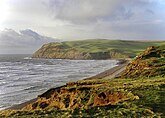
Back Cumbria Afrikaans Cumbria AN كمبريا Arabic كمبريا ARZ Cumbria AST Cumbria BAN Cumbria BAR Камбрыя Byelorussian Камбрыя BE-X-OLD Къмбрия Bulgarian
Cumbria | |
|---|---|
 Location of Cumbria within England | |
| Coordinates: 54°30′N 3°15′W / 54.500°N 3.250°W | |
| Sovereign state | United Kingdom |
| Constituent country | England |
| Region | North West England |
| Established | 1 April 1974 |
| Established by | Local Government Act 1972 |
| Time zone | UTC+0 (GMT) |
| • Summer (DST) | UTC+1 (BST) |
| UK Parliament | 6 MPs |
| Police | Cumbria Constabulary |
| Largest city | Carlisle |
| Ceremonial county | |
| Lord Lieutenant | Alexander Scott[1] |
| High Sheriff | Samantha Scott[2] |
| Area | 6,768 km2 (2,613 sq mi) |
| • Rank | 3rd of 48 |
| Population (2022)[3] | 503,033 |
| • Rank | 42nd of 48 |
| Density | 74/km2 (190/sq mi) |
| Ethnicity | |
| Districts | |
 Districts of Cumbria Unitary | |
| Districts | |
Cumbria (/ˈkʌmbriə/ KUM-bree-ə) is a ceremonial county in North West England. It borders the Scottish council areas of Dumfries and Galloway and Scottish Borders to the north, Northumberland and County Durham to the east, North Yorkshire to the south-east, Lancashire to the south, and the Irish Sea to the west. Its largest settlement is the city of Carlisle.
Cumbria is predominantly rural, with an area of 6,769 km2 (2,614 sq mi) and a population of 500,012; this makes it the third-largest ceremonial county in England by area but the eighth-smallest by population. Carlisle is located in the north; the towns of Workington and Whitehaven lie on the west coast, Barrow-in-Furness on the south coast, and Penrith and Kendal in the east of the county. For local government purposes the county comprises two unitary authority areas, Westmorland and Furness and Cumberland.[5] Cumbria was created in 1974 from the historic counties of Cumberland and Westmorland, the Furness area of Lancashire, and a small part of Yorkshire.
The interior of Cumbria contains several upland areas. Together they fringe the Vale of Eden, the wide valley of the River Eden, which runs south-east to north-west across the county and broadens into the Solway Plain near Carlisle.[6][7] To the north-east are part of the Border Moors, and to the east part of the North Pennines; the latter have been designated a national landscape. South of the vale are the Orton Fells, Howgill Fells, and part of the Yorkshire Dales, which are all within the Yorkshire Dales national park.[8] The south-west contains the Lake District, a large upland area which has been designated a national park and UNESCO World Heritage Site. It includes Scafell Pike, England's highest mountain,[9] and Windermere, its longest and largest lake. The county has long coast to the west which is bordered by a plain for most of its length. The north-west coast is part of the Solway Firth, a national landscape, and the south coast includes the Cartmel and Furness peninsulas. East of the peninsulas, the county contains part of Arnside and Silverdale, another national landscape
The county contains several Neolithic monuments, such as Mayburgh Henge. The region was on the border of Roman Britain, and Hadrian's Wall runs through the north of the county. In the Early Middle Ages parts of the region successively belonged to Rheged, Northumbria, and Strathclyde, and there was also a Viking presence. It became the border between England and Scotland, and was unsettled until the Union of the Crowns in 1603. During the Industrial Revolution mining took place on the Cumberland coalfield and Barrow-in-Furness became a shipbuilding centre, but the county was not heavily industrialised and the Lake District became valued for its sublime and picturesque qualities, notably by the Lake Poets.
- ^ "New Lord-Lieutenant of Cumbria appointed". Cumberland Council. 5 July 2023. Archived from the original on 7 January 2024. Retrieved 7 January 2024.
- ^ "No. 62943". The London Gazette. 13 March 2020. p. 5161.
- ^ "Mid-2022 population estimates by Lieutenancy areas (as at 1997) for England and Wales". Office for National Statistics. 24 June 2024. Retrieved 26 June 2024.
- ^ UK Census (2021). "2021 Census Area Profile – Cumbria County (E10000006)". Nomis. Office for National Statistics. Retrieved 23 October 2023.
- ^ "Names for two controversial Cumbria councils revealed". BBC News. 5 November 2021. Archived from the original on 24 November 2021. Retrieved 24 November 2021.
- ^ "Wastwater and the Lake District West Coast – explore and visit". Lake District National Park. 17 May 2013. Archived from the original on 22 September 2019. Retrieved 19 August 2019.
- ^ "Lake District National Park – Explore Windermere". Lakedistrict.gov.uk. Archived from the original on 3 April 2016. Retrieved 3 April 2016.
- ^ "An introduction to the Yorkshire Dales in the County of Cumbria". Visit Cumbria. Retrieved 1 April 2024.
- ^ Cumbrian Mountains: Philips' Elementary Atlas and Geography, edited by John Francon Williams published by George Philip & Son Ltd., 1882: (2) The Cumbrian Mountains are a group in the counties of Cumberland, Westmoreland, and northern Lancashire, near the coast of the Irish Sea. They contain the highest elevation in England – Scaw Fell (Scafell Pike), 3,208 feet above the level of the sea (retrieved 2018)


